Critical Wind Direction Angles and Edge Module Vulnerability in Fixed Double-Row Photovoltaic (PV) Arrays: Analysis of Extreme Wind Conditions Based on CFD Simulation
Abstract
1. Introduction
1.1. Research Background
1.2. Literature Review of Relevant Studies
1.2.1. Methodology of Wind Load Characterization of Photovoltaic (PV) Panels
1.2.2. Wind Load Characteristics of Photovoltaic Panels Under Different Mounting Methods
1.3. Research Gaps and Contributions of This Study
2. Materials and Methods
2.1. Array Modeling and Computational Domain Size
2.2. Mesh Division and Solution Condition Setting
2.3. Definition of Component Wind Load Parameters
2.4. Computational Validation of Wind Loads on PV Panels
3. Results and Analysis
3.1. Wind Load Characterization of PV Panels
3.1.1. Wind Load Characteristics of Front Row PV Modules
3.1.2. Wind Load Distribution Characteristics of the Rear Row PV Modules
3.2. Wind Pressure Distribution on the Surface of PV Panels
4. Discussion
4.1. Discussion of Research Results
4.1.1. Critical Working Conditions for Arrays and Discussion of the Most Unfavorable Positions
4.1.2. Discussion of Wind Load Variability Between Top-Row and Bottom-Row Photovoltaic Panels
4.1.3. Discussion on the Effect of Different Structural Rigidity of Support Structures on Wind Load Distribution
4.2. Limitations and Outlook of This Study
5. Conclusions
- (1)
- When the wind direction angle is 0°, the mean net pressure coefficients of the front-row PV modules reach the maximum. When the wind direction angle is 180°, the mean net pressure coefficients of the rear-row PV modules reach their maximum. However, for the PV modules at the edges, the mean net pressure coefficients are the largest at wind direction angles around 45° and 135°. In contrast, when the wind direction angle is 90°, the mean net pressure coefficients of the PV modules are the smallest, indicating that this wind direction angle is a favorable condition for the wind resistance of the structure. Therefore, during the installation and layout of the array, this condition can be given priority, and the array should be oriented as much as possible to be consistent with the 90° incoming wind direction to significantly improve the structural safety.
- (2)
- The variation trends of the drag coefficient and lift coefficient of the PV modules are similar to those of the mean net pressure coefficients. The critical wind direction angles are as follows: 0° and 180° correspond to the maximum lift and drag coefficients of the middle-part PV modules in the front and rear rows, respectively, while around 45° and 135° correspond to the maximum lift and drag coefficients of the PV modules at the edges. Hence, in the array layout design, these oblique wind conditions should be avoided as much as possible.
- (3)
- Under oblique wind conditions with wind direction angles around 45° and 135°, the PV modules at the four edges of the array are subjected to relatively large overturning moments. Given that large overturning moments may increase the risk of damage to the edge components, it is recommended that special reinforcement measures, such as increasing the number of fixing points or using high-strength connectors, be implemented at these critical parts during the design and installation process to prevent wind-induced damage.
- (4)
- The maximum values of the wind pressure coefficients of the PV array occur in the PV modules at the four edges under oblique-wind conditions, and the wind pressure they experience is significantly higher than that in other conditions and at other positions of the PV modules. This further confirms that the periphery of the PV module group is the most unfavorable area for wind loads. Additionally, when the wind comes from the front (wind direction angles from 0° to 90°), the lower-row PV modules bear relatively large wind loads; when the wind comes from the reverse direction (wind direction angles from 90° to 180°), the upper-row PV modules are subjected to relatively large wind loads. Therefore, in practical engineering, wind-resistance measures for the corresponding position components should be strengthened based on the characteristics of the local dominant wind direction.
Author Contributions
Funding
Data Availability Statement
Conflicts of Interest
References
- Almutairi, K.; Hosseini Dehshiri, S.S.; Mostafaeipour, A.; Issakhov, A.; Techato, K.; Arockia Dhanraj, J. Performance optimization of a new flash-binary geothermal cycle for power/hydrogen production with zeotropic fluid. J. Therm. Anal. Calorim. 2021, 145, 1633–1650. [Google Scholar] [CrossRef]
- Dias, R.R.; Deprá, M.C.; Severo, I.A.; Zepka, L.Q.; Jacob-Lopes, E. Smart override of the energy matrix in commercial microalgae facilities: A transition path to a low-carbon bioeconomy. Sustain. Energy Technol. Assess. 2022, 52, 102073. [Google Scholar] [CrossRef]
- Asiabanpour, B.; Almusaied, Z.; Rainosek, K.; Davidson, K. A comparison between simulation and empirical methods to determine fixed versus sun-tracking photovoltaic panel performance. Int. J. Comput. Appl. Technol. 2019, 60, 37–50. [Google Scholar] [CrossRef]
- Bahrami, A.; Okoye, C.O.; Pourasl, H.H.; Khojastehnezhad, V.M. Techno-economic comparison of fixed and tracking flat plate solar collectors in the northern hemisphere. J. Clean. Prod. 2022, 378, 134523. [Google Scholar] [CrossRef]
- Hammad, B.; Al-Sardeah, A.; Al-Abed, M.; Nijmeh, S.; Al-Ghandoor, A. Performance and economic comparison of fixed and tracking photovoltaic systems in Jordan. Renew. Sustain. Energy Rev. 2017, 80, 827–839. [Google Scholar] [CrossRef]
- Mirzaei Darian, M.; Ghorreshi, A. Comparison of the effect of temperature parameter on tracking and fixed photovoltaic systems: A case study in Tehran, Iran. Sci. Iran. 2020, 28, 1298–1305. [Google Scholar] [CrossRef]
- Bahrami, A.; Okoye, C.O.; Atikol, U. Technical and economic assessment of fixed, single and dual-axis tracking PV panels in low latitude countries. Renew. Energy 2017, 113, 563–579. [Google Scholar] [CrossRef]
- Koussa, M.; Cheknane, A.; Hadji, S.; Haddadi, M.; Noureddine, S. Measured and modelled improvement in solar energy yield from flat plate photovoltaic systems utilizing different tracking systems and under a range of environmental conditions. Appl. Energy 2011, 88, 1756–1771. [Google Scholar] [CrossRef]
- Lave, M.; Kleissl, J. Optimum fixed orientations and benefits of tracking for capturing solar radiation in the continental United States. Renew. Energy 2011, 36, 1145–1152. [Google Scholar] [CrossRef]
- Hamdi, B.M.; Dewi, T. Performance Comparison of 3 Kwp Solar Panels Between Fixed and Sun Tracking in Palembang-Indonesia. In Proceedings of the IOP Conference Series: Earth and Environmental Science, Manila, The Philippines, 18–21 October 2018; p. 012131. [Google Scholar]
- Listewnik, K.J.; Nowak, T. Comparison of the Energy Efficiency of Fixed and Tracking Home Photovoltaic Systems in Northern Poland. Energies 2024, 17, 4410. [Google Scholar] [CrossRef]
- Deng, E.; Liu, X.-Y.; Yue, H.; Yang, W.-C.; Ouyang, D.-H.; Ni, Y.-Q. How do dunes along a desert urban motorway affect the driving safety of sedans? Evidences from long-and short-term monitoring and IDDES. J. Wind Eng. Ind. Aerodyn. 2023, 243, 105595. [Google Scholar] [CrossRef]
- SAuCA, A.C.; Milchis, T.; Gobesz, F.-Z. Wind loading on solar panels. Pap. Tech. Sci. 2019, 10, 73–78. [Google Scholar] [CrossRef][Green Version]
- Valentín, D.; Valero, C.; Egusquiza, M.; Presas, A. Failure investigation of a solar tracker due to wind-induced torsional galloping. Eng. Fail. Anal. 2022, 135, 106137. [Google Scholar] [CrossRef]
- Wang, J.; Deng, E.; Ni, Y.-Q.; He, X.-H.; Chan, P.-W.; Yang, W.-C.; Li, H.; Xie, Z.-Y. Mitigating inflow acceleration effects in twin mountains using air jets: Emphasis on anti-wind for high-speed railways. Phys. Fluids 2024, 36, 055128. [Google Scholar] [CrossRef]
- Huang, B.; Li, Z.; Zhao, Z.; Wu, H.; Zhou, H.; Cong, S. Near-ground impurity-free wind and wind-driven sand of photovoltaic power stations in a desert area. J. Wind Eng. Ind. Aerodyn. 2018, 179, 483–502. [Google Scholar] [CrossRef]
- Bao, T.; Li, Z.; Pu, O.; Wu, H. Field Measurement and Analysis of Near-Ground Wind Field Characteristics and Wind Pressure on Tracking Photovoltaic Panels. Energy 2025, 321, 135400. [Google Scholar] [CrossRef]
- Bao, T.; Li, Z.; Pu, O.; Yang, Y.; Huang, B.; Wu, H. Field measurement-based research on wind pressure interference effects of tracking photovoltaic arrays. J. Wind Eng. Ind. Aerodyn. 2025, 257, 105971. [Google Scholar] [CrossRef]
- Bender, W.; Waytuck, D.; Wang, S.; Reed, D. In situ measurement of wind pressure loadings on pedestal style rooftop photovoltaic panels. Eng. Struct. 2018, 163, 281–293. [Google Scholar] [CrossRef]
- Geurts, C.; Blackmore, P. Wind loads on stand-off photovoltaic systems on pitched roofs. J. Wind Eng. Ind. Aerodyn. 2013, 123, 239–249. [Google Scholar] [CrossRef]
- Gong, B.; Wang, Z.; Li, Z.; Zhang, J.; Fu, X. Field measurements of boundary layer wind characteristics and wind loads of a parabolic trough solar collector. Sol. Energy 2012, 86, 1880–1898. [Google Scholar] [CrossRef]
- Shademan, M.; Barron, R.; Balachandar, R.; Hangan, H. Numerical simulation of wind loading on ground-mounted solar panels at different flow configurations. Can. J. Civ. Eng. 2014, 41, 728–738. [Google Scholar] [CrossRef]
- Xu, Z.; Lian, J.; Zhang, J.; Bin, L. Investigating and optimizing the water footprint in a typical coal energy and chemical base of China. Sci. Total Environ. 2020, 727, 138781. [Google Scholar] [CrossRef] [PubMed]
- Bao, T.; Li, Z.; Pu, O.; Chan, R.W.; Zhao, Z.; Pan, Y.; Yang, Y.; Huang, B.; Wu, H. Modal analysis of tracking photovoltaic support system. Sol. Energy 2023, 265, 112088. [Google Scholar] [CrossRef]
- Kaabia, B.; Langlois, S.; Légeron, F. Full-scale measurement of the response of a CPV tracker structure prototype under wind load. Sol. Energy 2017, 147, 368–380. [Google Scholar] [CrossRef]
- Alrawashdeh, H.; Stathopoulos, T. Wind loading of rooftop PV panels cover plate: A codification-oriented study. J. Wind Eng. Ind. Aerodyn. 2023, 240, 105489. [Google Scholar] [CrossRef]
- Blocken, B.; Stathopoulos, T.; Van Beeck, J. Pedestrian-level wind conditions around buildings: Review of wind-tunnel and CFD techniques and their accuracy for wind comfort assessment. Build. Environ. 2016, 100, 50–81. [Google Scholar] [CrossRef]
- Jubayer, C.M.; Hangan, H. Numerical simulation of wind effects on a stand-alone ground mounted photovoltaic (PV) system. J. Wind Eng. Ind. Aerodyn. 2014, 134, 56–64. [Google Scholar] [CrossRef]
- Jubayer, C.M.; Hangan, H. A numerical approach to the investigation of wind loading on an array of ground mounted solar photovoltaic (PV) panels. J. Wind Eng. Ind. Aerodyn. 2016, 153, 60–70. [Google Scholar] [CrossRef]
- Warsido, W.P.; Bitsuamlak, G.T.; Barata, J.; Chowdhury, A.G. Influence of spacing parameters on the wind loading of solar array. J. Fluids Struct. 2014, 48, 295–315. [Google Scholar] [CrossRef]
- Winkelmann, U.; Kämper, C.; Höffer, R.; Forman, P.; Ahrens, M.A.; Mark, P. Wind actions on large-aperture parabolic trough solar collectors: Wind tunnel tests and structural analysis. Renew. Energy 2020, 146, 2390–2407. [Google Scholar] [CrossRef]
- Browne, M.T.; Taylor, Z.J.; Li, S.; Gamble, S. A wind load design method for ground-mounted multi-row solar arrays based on a compilation of wind tunnel experiments. J. Wind Eng. Ind. Aerodyn. 2020, 205, 104294. [Google Scholar] [CrossRef]
- Cárdenas-Rondón, J.A.; Ogueta-Gutiérrez, M.; Franchini, S.; Manzanares-Bercial, R. Stability analysis of two-dimensional flat solar trackers using aerodynamic derivatives at different heights above ground. J. Wind Eng. Ind. Aerodyn. 2023, 243, 105606. [Google Scholar] [CrossRef]
- Abiola-Ogedengbe, A.; Hangan, H.; Siddiqui, K. Experimental investigation of wind effects on a standalone photovoltaic (PV) module. Renew. Energy 2015, 78, 657–665. [Google Scholar] [CrossRef]
- Choi, S.M.; Park, C.-D.; Cho, S.-H.; Lim, B.-J. Effects of wind loads on the solar panel array of a floating photovoltaic system–Experimental study and economic analysis. Energy 2022, 256, 124649. [Google Scholar] [CrossRef]
- Li, S.; Mao, D.; Li, S.; Wang, Q.; Yang, Q.; Chen, Y.; Zhou, S. Wind load characteristics of photovoltaic panel arrays mounted on flat roof. Eng. Res. Express 2022, 4, 015027. [Google Scholar] [CrossRef]
- Wang, J.; Liu, M.; Yang, Q.; Hui, Y.; Nie, S. Extreme Wind Loading on Flat-Roof-Mounted Solar Arrays with Consideration of Wind Directionality. Buildings 2023, 13, 221. [Google Scholar] [CrossRef]
- Agarwal, A.; Irtaza, H.; Zameel, A. Numerical study of lift and drag coefficients on a ground-mounted photo-voltaic solar panel. Mater. Today Proc. 2017, 4, 9822–9827. [Google Scholar] [CrossRef]
- Zhang, J.; Lou, Y. Study of Wind Load Influencing Factors of Flexibly Supported Photovoltaic Panels. Buildings 2024, 14, 1677. [Google Scholar] [CrossRef]
- Khan, A.Y.; Ahmad, Z.; Sultan, T.; Alshahrani, S.; Hayat, K.; Imran, M. Optimization of photovoltaic panel array configurations to reduce lift force using genetic algorithm and CFD. Energies 2022, 15, 9580. [Google Scholar] [CrossRef]
- Li, T.; Zhang, Y.; Yang, Q.; Zhou, X.; Zhang, Z.; Wang, T. Unsteady aerodynamic characteristics of a floating offshore wind turbine in propeller state. Renew. Energy 2025, 246, 122861. [Google Scholar] [CrossRef]
- Xu, A.; Ma, W.; Yuan, H.; Lu, L. The effects of row spacing and ground clearance on the wind load of photovoltaic (PV) arrays. Renew. Energy 2024, 220, 119627. [Google Scholar] [CrossRef]
- Stathopoulos, T.; Zisis, I.; Xypnitou, E. Local and overall wind pressure and force coefficients for solar panels. J. Wind Eng. Ind. Aerodyn. 2014, 125, 195–206. [Google Scholar] [CrossRef]
- Fu, X.; Ren, R.-X.; Li, J.; Li, G.; Zhu, H.-Y.; Zhai, J. Experimental and numerical study on the aerodynamic characteristics of a double-row photovoltaic panel. J. Wind Eng. Ind. Aerodyn. 2024, 253, 105846. [Google Scholar] [CrossRef]
- Chi, Y.; Nan, B.; Qiao, Y.; Leng, J. A Parametric Study of Flexible Support Deflection of Photovoltaic Cells Considering Wind-Induced Load Using Time History Technique. Buildings 2024, 14, 2706. [Google Scholar] [CrossRef]
- Li, J.; Tong, L.; Wu, J.; Pan, Y. Numerical investigation of wind influences on photovoltaic arrays mounted on roof. Eng. Appl. Comput. Fluid Mech. 2019, 13, 905–922. [Google Scholar] [CrossRef]
- Xu, A.; Ma, W.; Yang, W.; Li, M.; Tan, Y.; Zou, C.; Qiang, S. Study on the wind load and wind-induced interference effect of photovoltaic (PV) arrays on two-dimensional hillsides. Sol. Energy 2024, 278, 112790. [Google Scholar] [CrossRef]
- Wan, J.; Cai, Y.; Fang, H. An experimental study of aerodynamics on cable-supported photovoltaic panel arrays at different tilt angles. J. Wind Eng. Ind. Aerodyn. 2025, 262, 106093. [Google Scholar] [CrossRef]
- Yao, J.; Tu, Z.; Xu, H. Experimental investigation of wind pressures on photovoltaic (PV) array mounted on a hilly terrain. Sol. Energy 2025, 291, 113256. [Google Scholar] [CrossRef]
- Wu, Y.; Wu, Y.; Sun, Y.; Sun, X. Wind-induced vibration response and suppression of the cable-truss flexible support photovoltaic module array. Sol. Energy 2024, 284, 113096. [Google Scholar] [CrossRef]
- Tominaga, Y.; Mochida, A.; Yoshie, R.; Kataoka, H.; Nozu, T.; Yoshikawa, M.; Shirasawa, T. AIJ guidelines for practical applications of CFD to pedestrian wind environment around buildings. J. Wind Eng. Ind. Aerodyn. 2008, 96, 1749–1761. [Google Scholar] [CrossRef]
- Blocken, B.; Stathopoulos, T.; Carmeliet, J. CFD simulation of the atmospheric boundary layer: Wall function problems. Atmos. Environ. 2007, 41, 238–252. [Google Scholar] [CrossRef]
- Cárdenas-Rondón, J.A.; Carbajosa, C.; Marín-Coca, S.; Martínez-Cava, A. Parametric analysis of self-excited aeroelastic instability of an isolated single-axis two-dimensional flat solar tracker. Results Eng. 2024, 24, 103539. [Google Scholar] [CrossRef]
- He, X.-H.; Ding, H.; Jing, H.-Q.; Wu, X.-P.; Weng, X.-J. Mechanical characteristics of a new type of cable-supported photovoltaic module system. Sol. Energy 2021, 226, 408–420. [Google Scholar] [CrossRef]
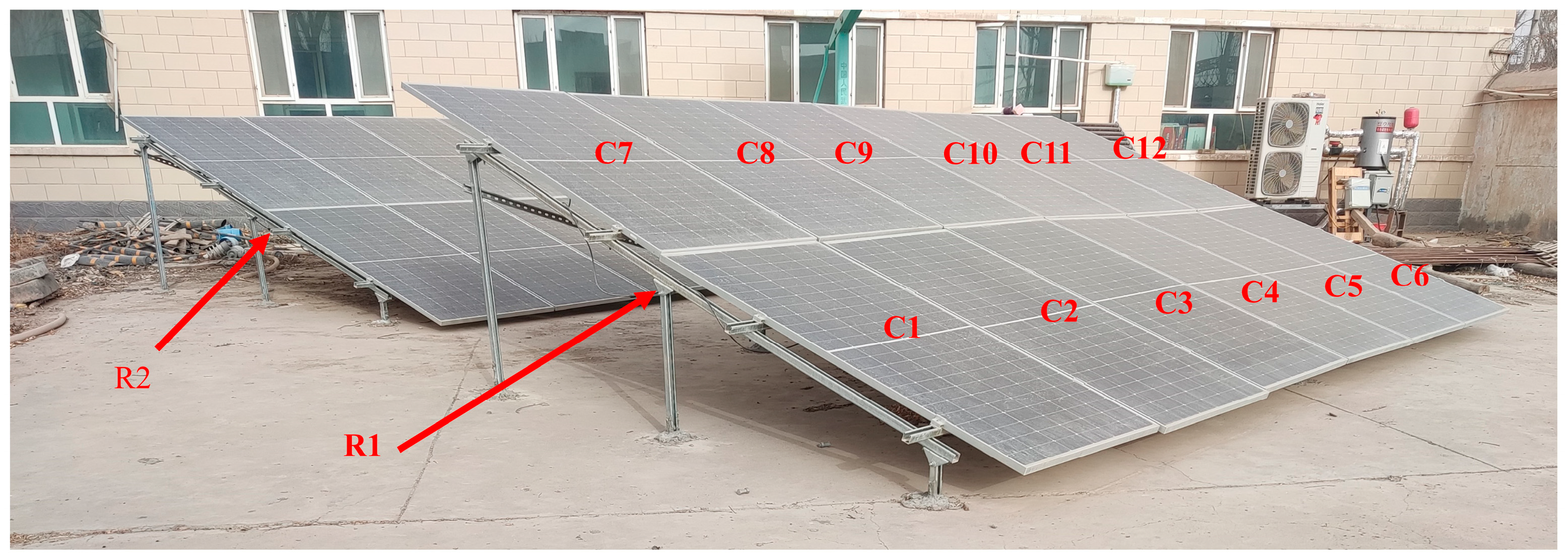
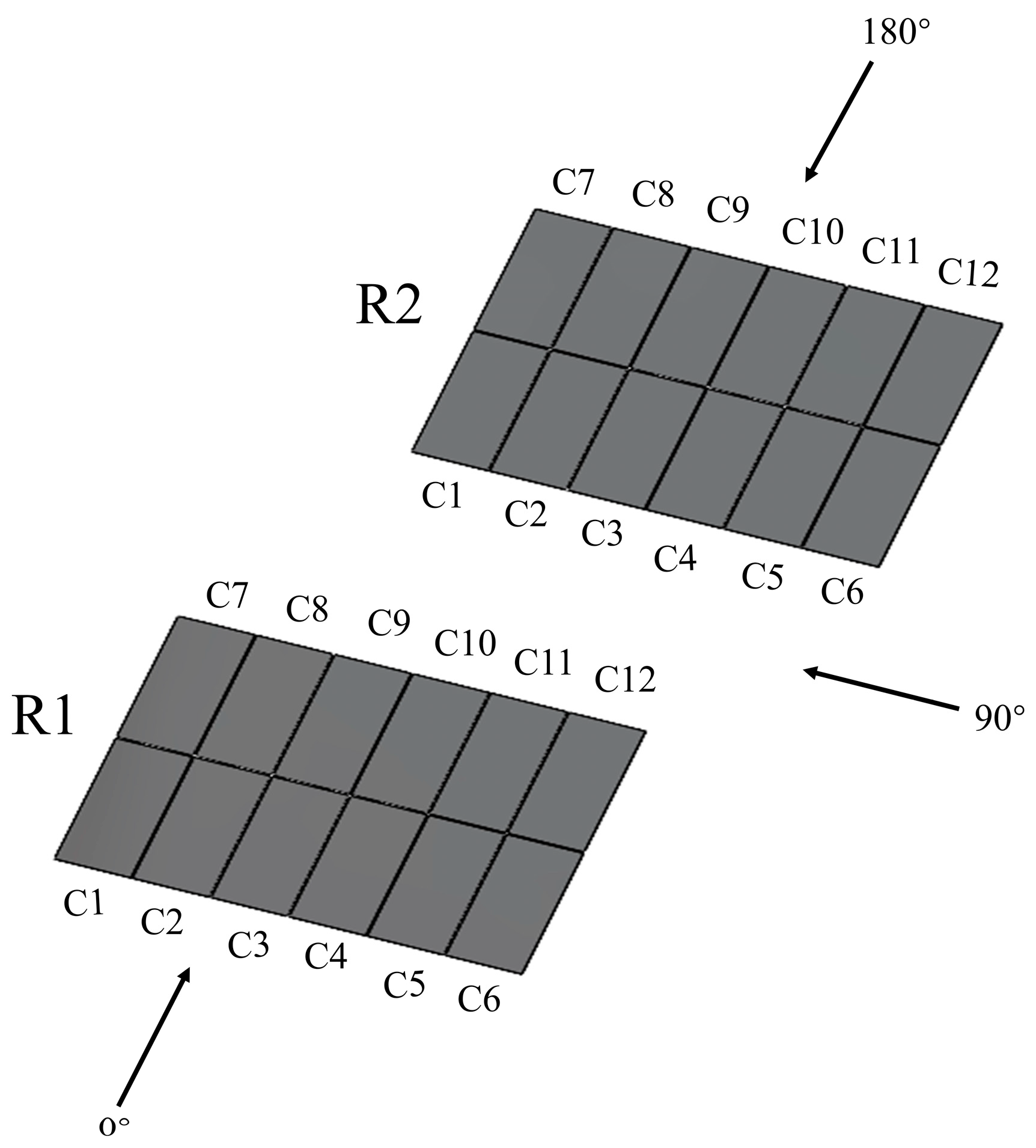
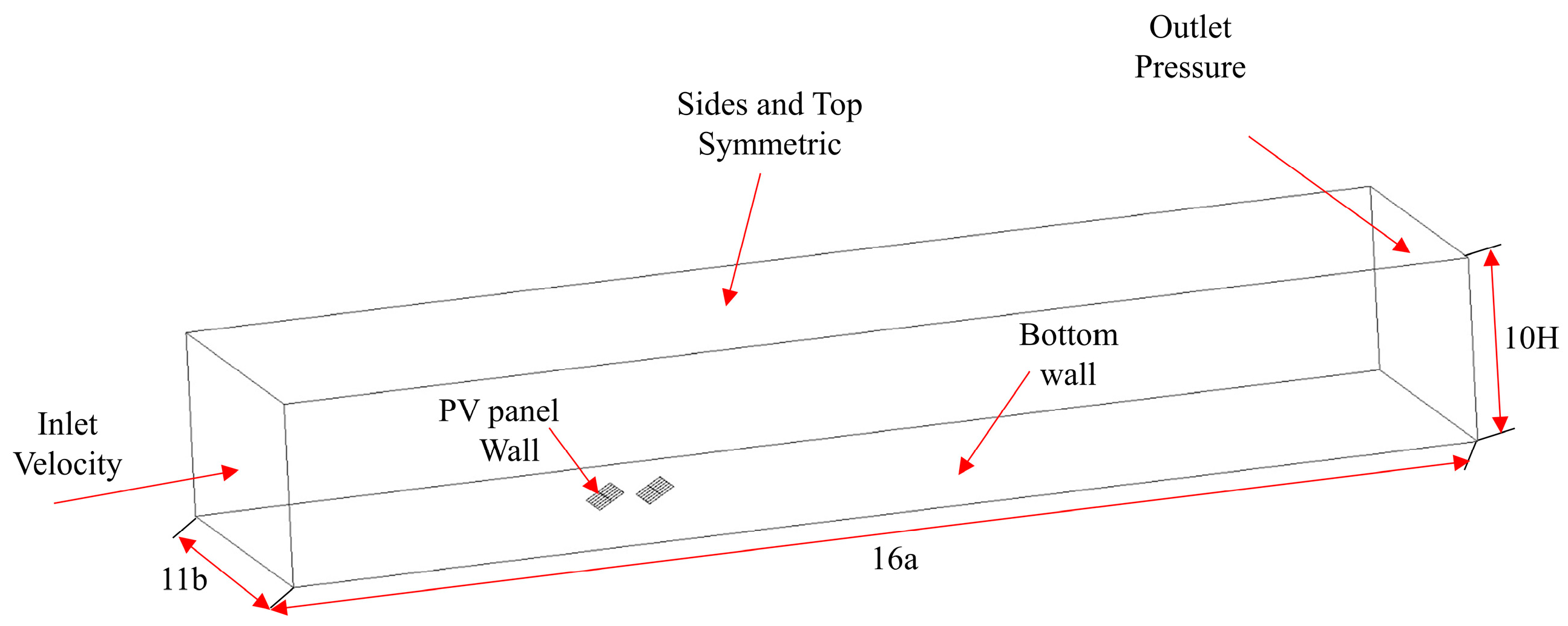





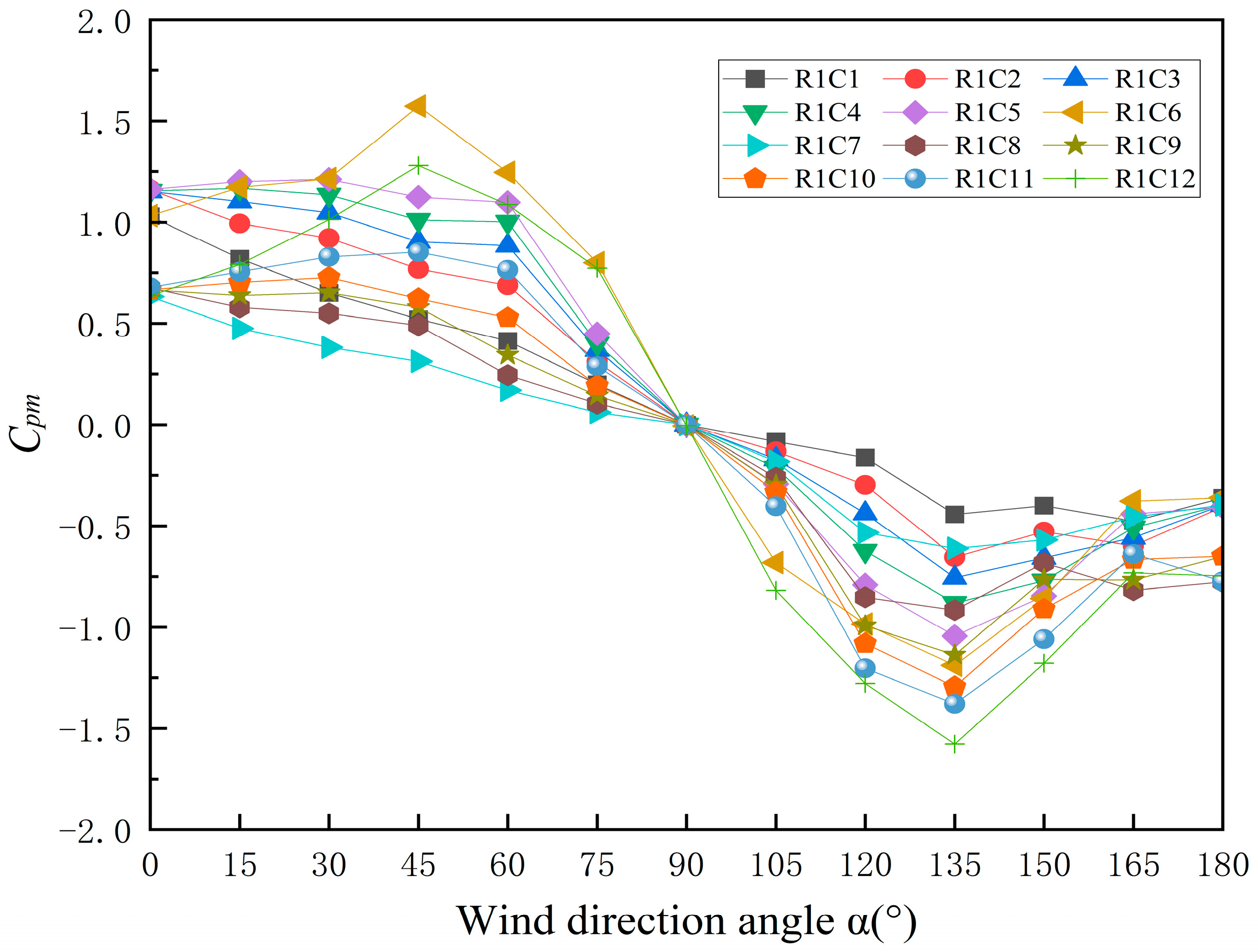
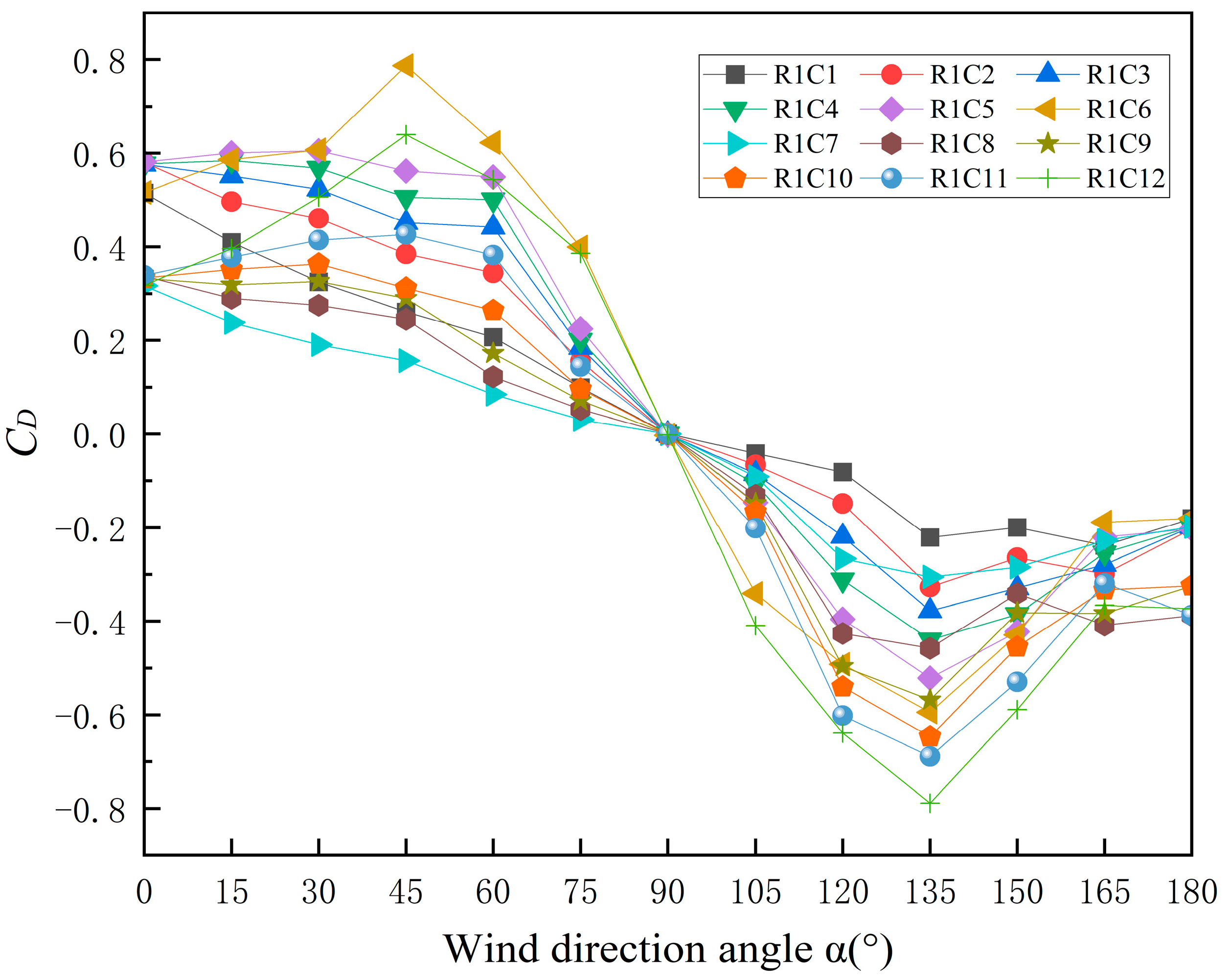
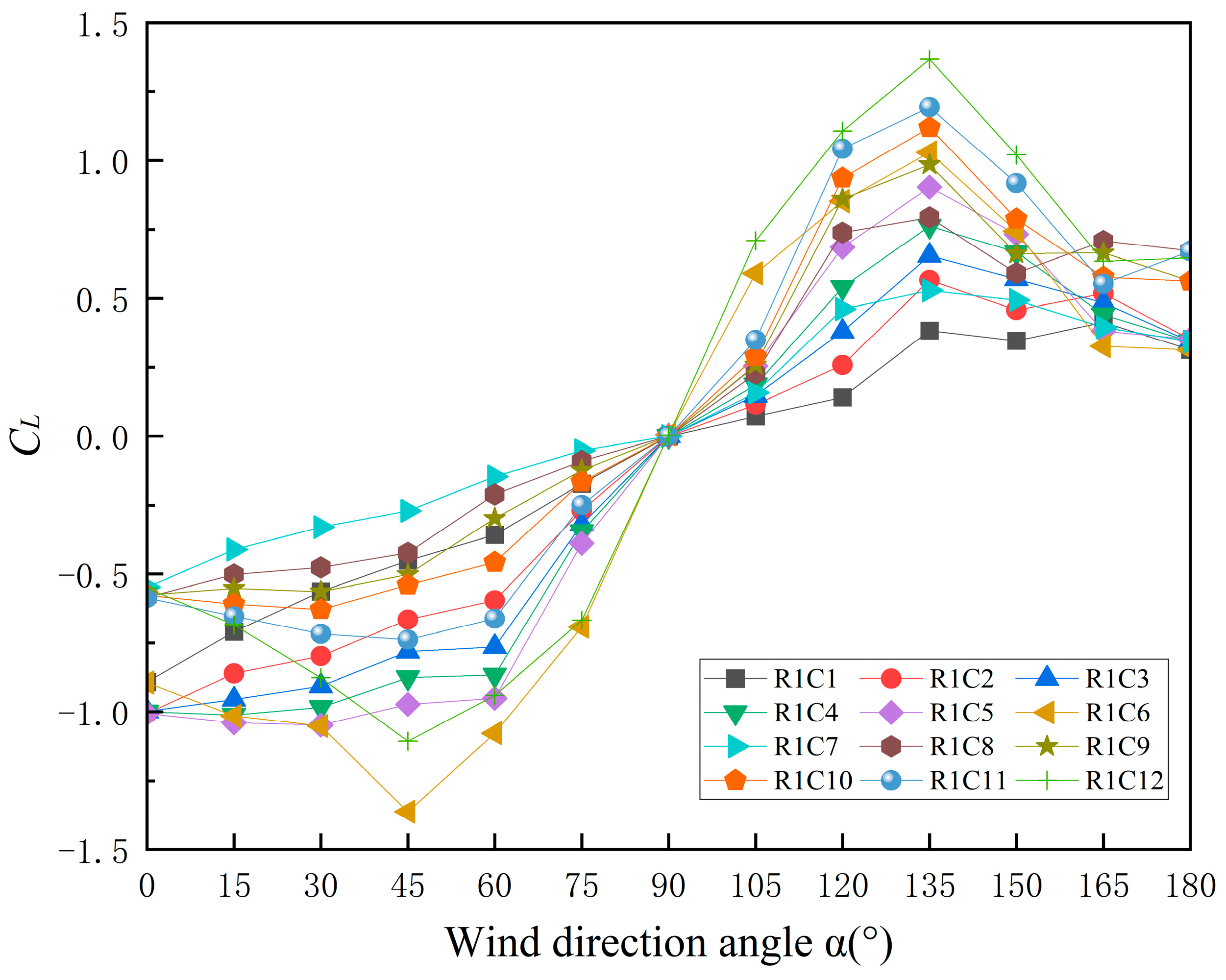
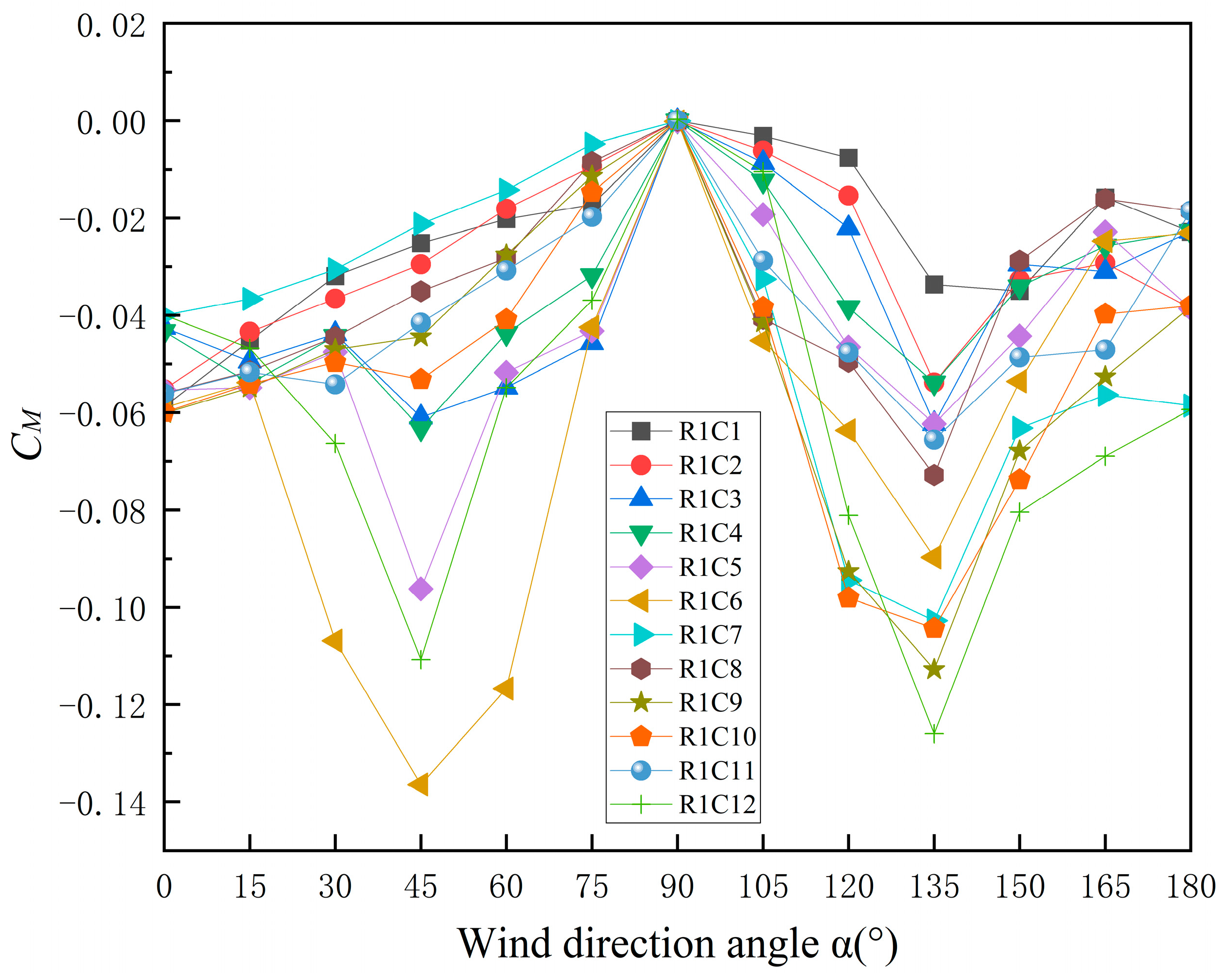
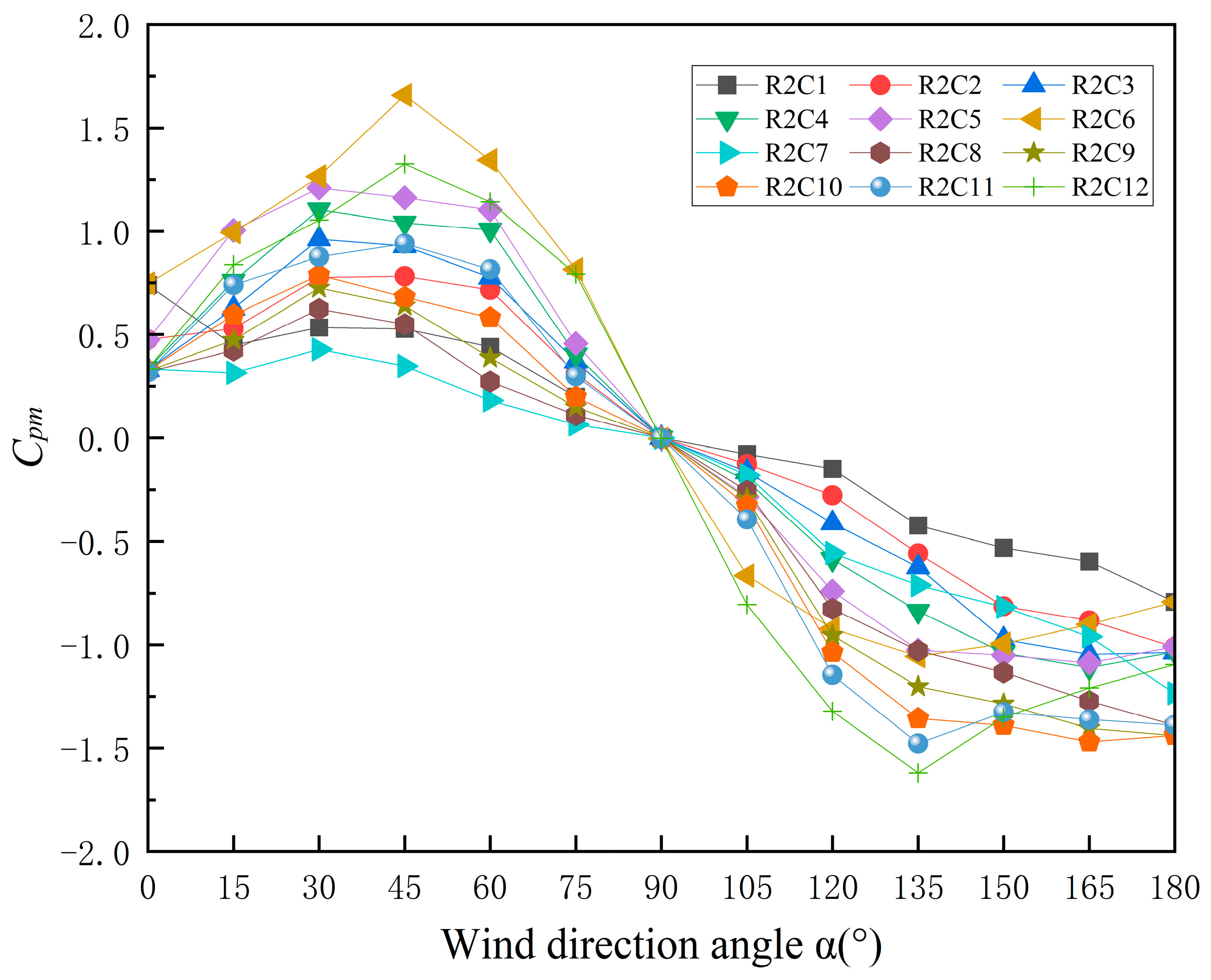



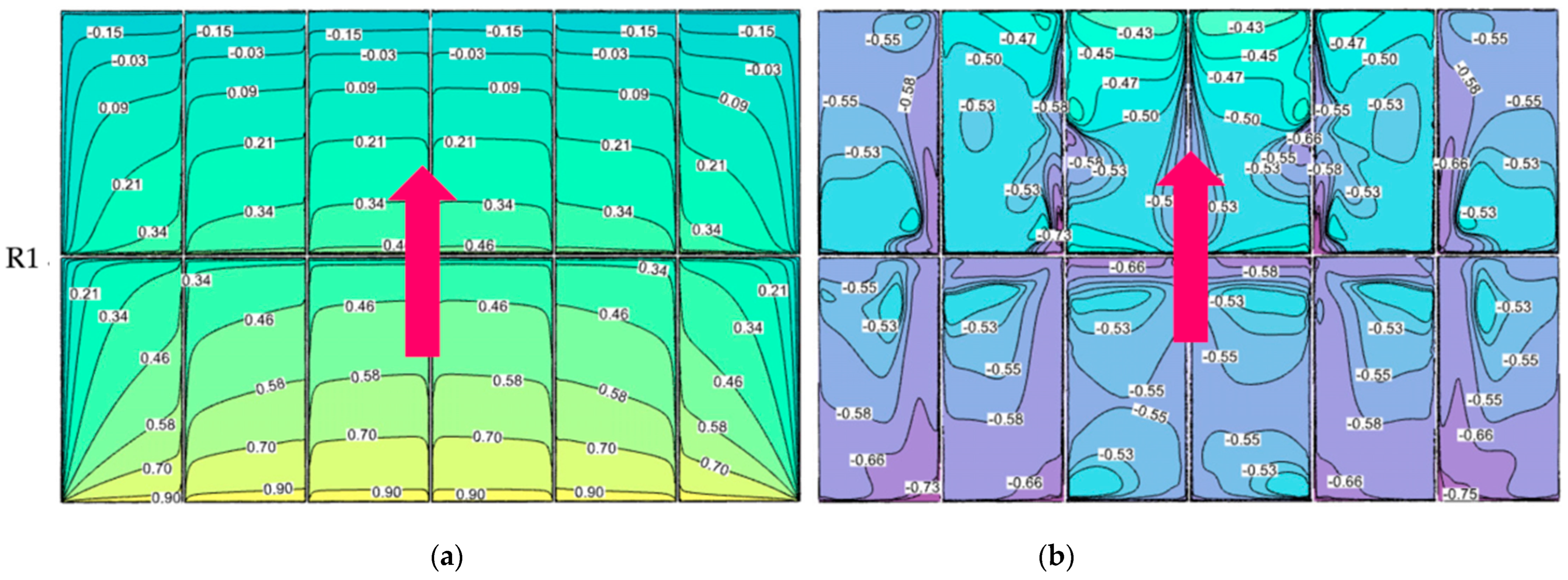
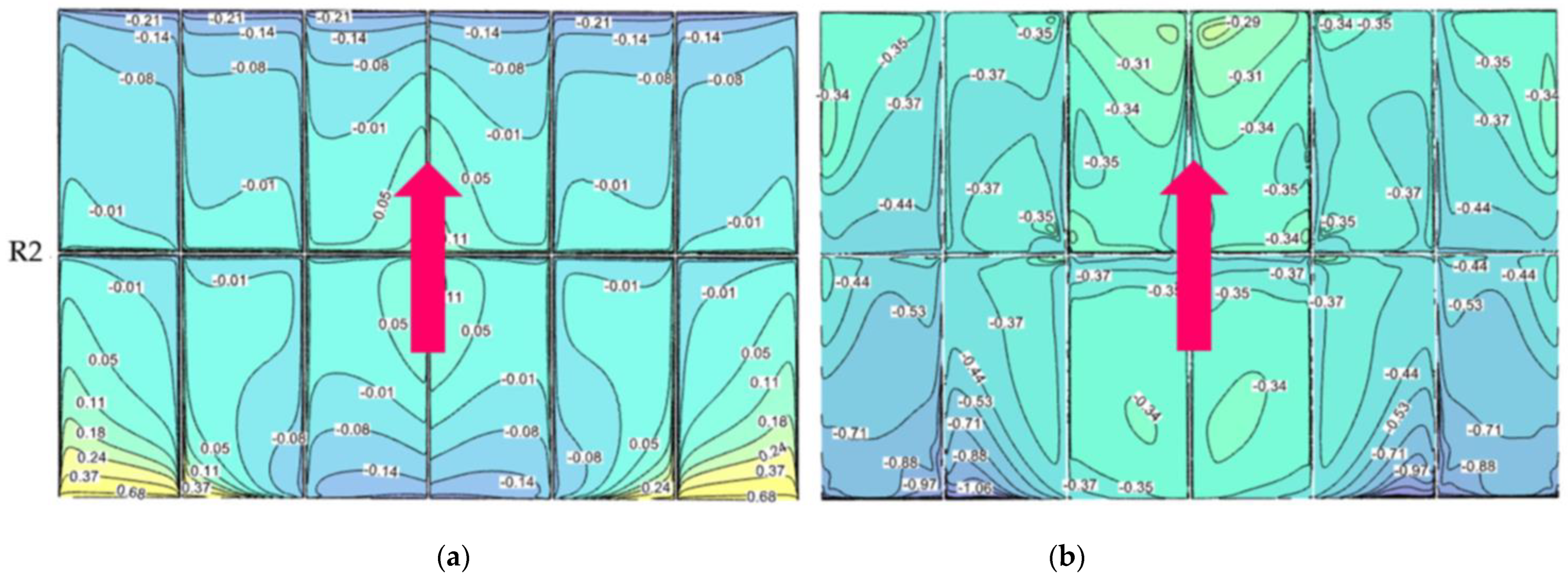
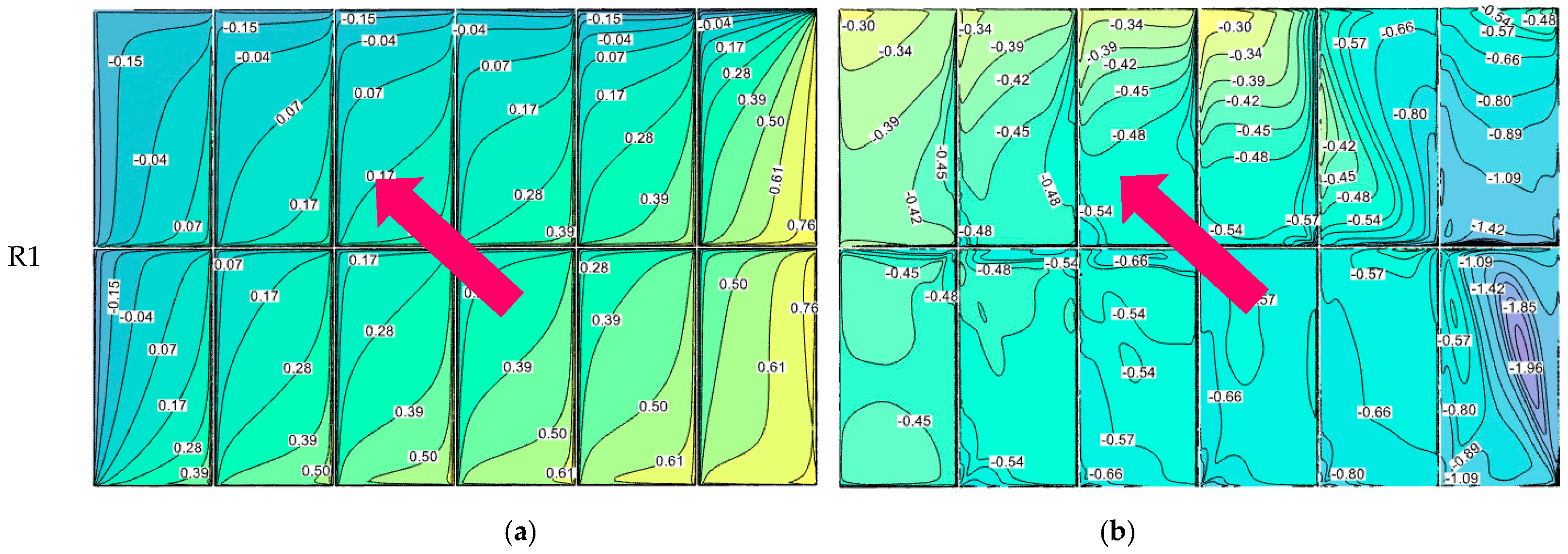
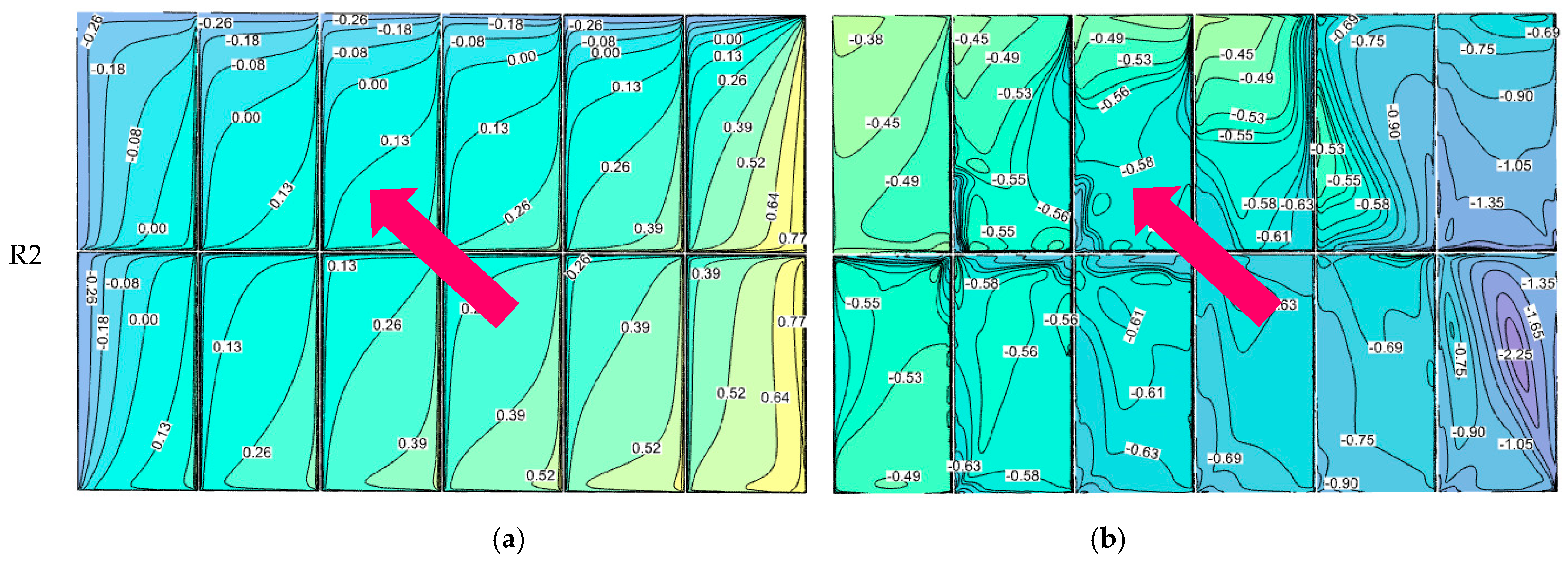

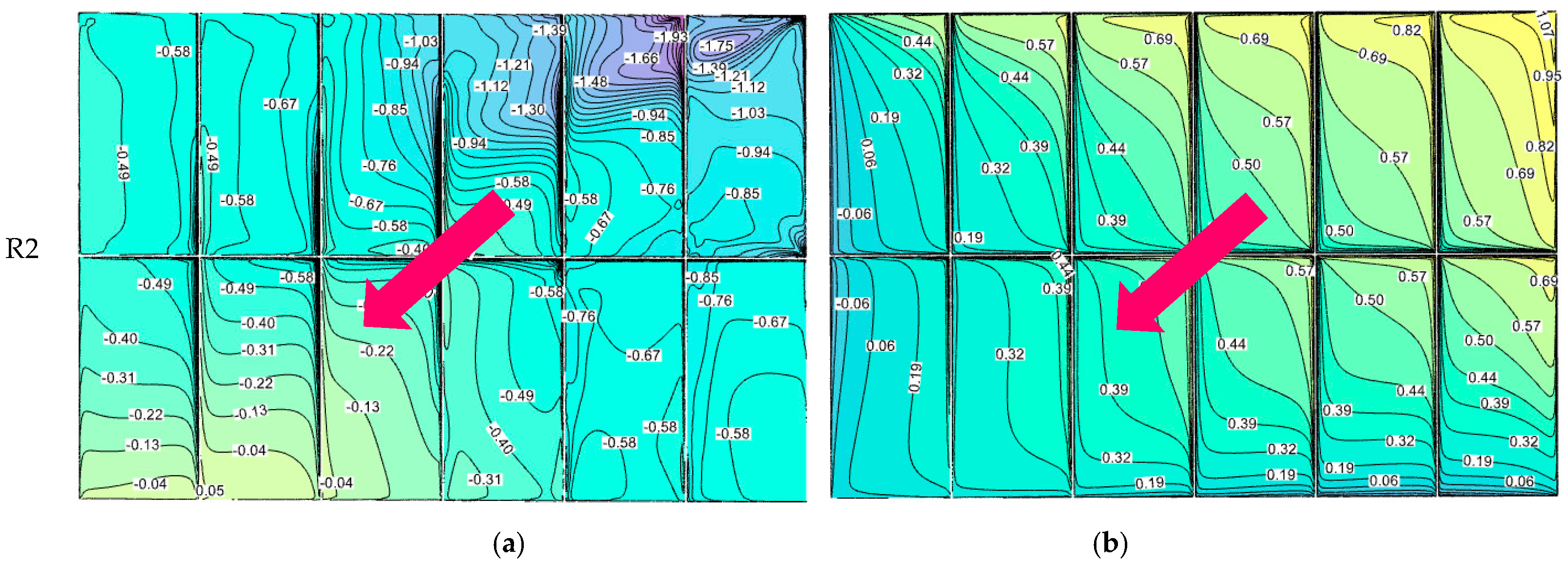
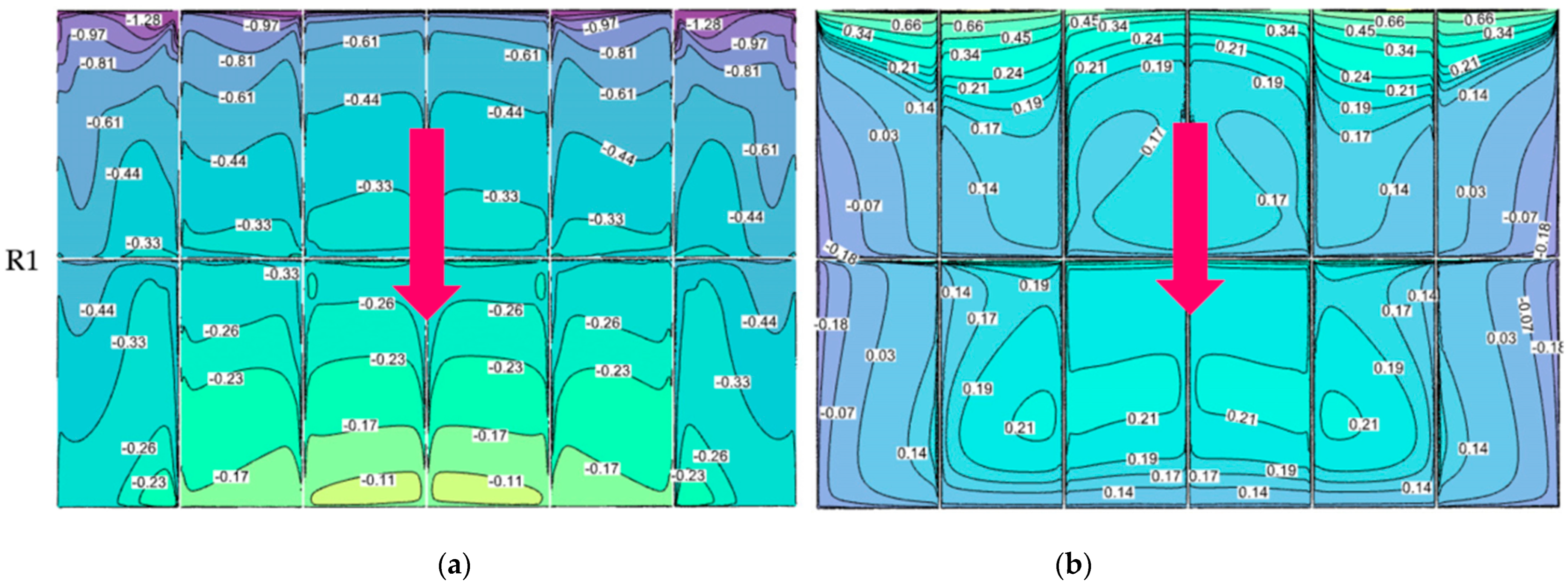

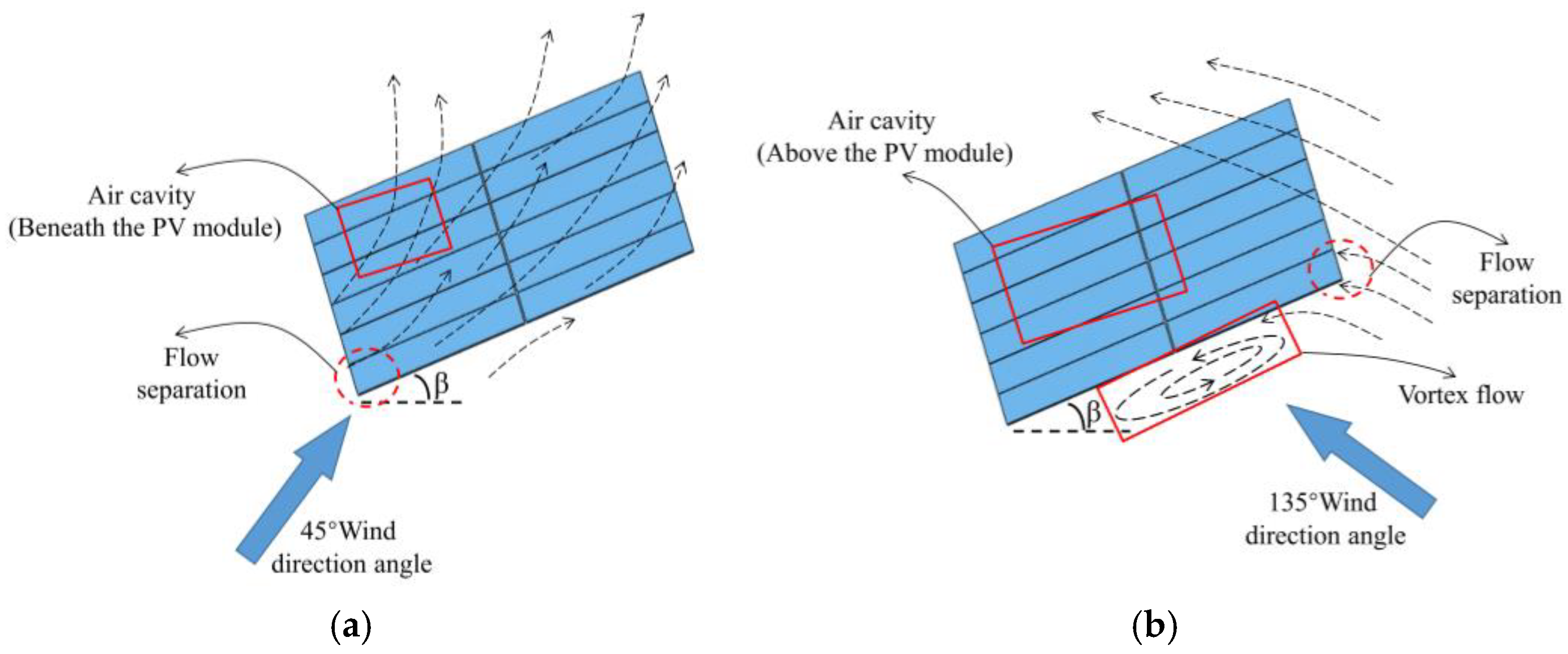
| Mesh | Drag Coefficients | Lift Coefficients | Torque Coefficients |
|---|---|---|---|
| G1 | 0.481 | −0.816 | −0.051 |
| G2 | 0.515 | −0.892 | −0.059 |
| G3 | 0.523 | −0.907 | −0.063 |
| Boundary | Boundary Conditions | Mathematical Implication |
|---|---|---|
| Inlet | Speed inlet | U U(z) = U0(z/z0)0.16 |
| K k(z) = 1.5(v(z)I(z))2 | ||
| ε ε = I1.5/l | ||
| Outlet | Pressure outlet | k, ε: the same as those at the inlet boundary |
| Side | Symmetry | (u,w,k,ε,ω) = 0 |
| Top | Symmetry | (u,v,k,ε,ω) = 0 |
| Model surface | Wall | Standard wall function: KS = 0 |
| Land surface | Wall | Standard wall function: KS = 0 |
Disclaimer/Publisher’s Note: The statements, opinions and data contained in all publications are solely those of the individual author(s) and contributor(s) and not of MDPI and/or the editor(s). MDPI and/or the editor(s) disclaim responsibility for any injury to people or property resulting from any ideas, methods, instructions or products referred to in the content. |
© 2025 by the authors. Licensee MDPI, Basel, Switzerland. This article is an open access article distributed under the terms and conditions of the Creative Commons Attribution (CC BY) license (https://creativecommons.org/licenses/by/4.0/).
Share and Cite
Hu, Y.; Zhang, H.; Luo, Z.; Zhou, Y.; Yuan, G. Critical Wind Direction Angles and Edge Module Vulnerability in Fixed Double-Row Photovoltaic (PV) Arrays: Analysis of Extreme Wind Conditions Based on CFD Simulation. Energies 2025, 18, 2330. https://doi.org/10.3390/en18092330
Hu Y, Zhang H, Luo Z, Zhou Y, Yuan G. Critical Wind Direction Angles and Edge Module Vulnerability in Fixed Double-Row Photovoltaic (PV) Arrays: Analysis of Extreme Wind Conditions Based on CFD Simulation. Energies. 2025; 18(9):2330. https://doi.org/10.3390/en18092330
Chicago/Turabian StyleHu, Yuheng, Hongzhou Zhang, Zhenwei Luo, Yupeng Zhou, and Guoshun Yuan. 2025. "Critical Wind Direction Angles and Edge Module Vulnerability in Fixed Double-Row Photovoltaic (PV) Arrays: Analysis of Extreme Wind Conditions Based on CFD Simulation" Energies 18, no. 9: 2330. https://doi.org/10.3390/en18092330
APA StyleHu, Y., Zhang, H., Luo, Z., Zhou, Y., & Yuan, G. (2025). Critical Wind Direction Angles and Edge Module Vulnerability in Fixed Double-Row Photovoltaic (PV) Arrays: Analysis of Extreme Wind Conditions Based on CFD Simulation. Energies, 18(9), 2330. https://doi.org/10.3390/en18092330





